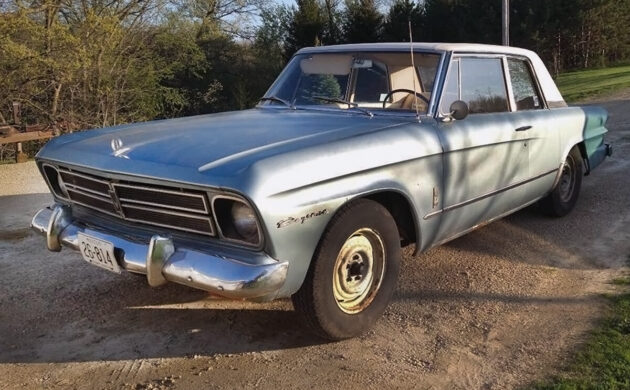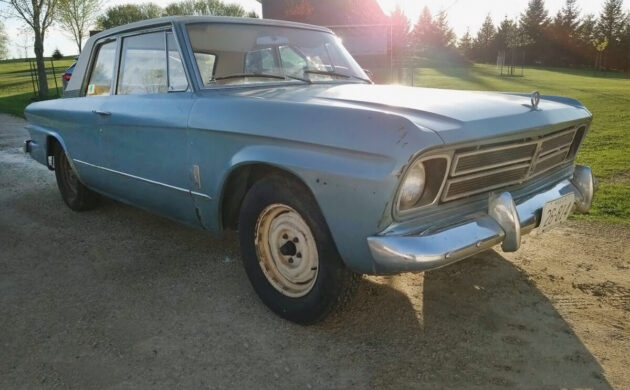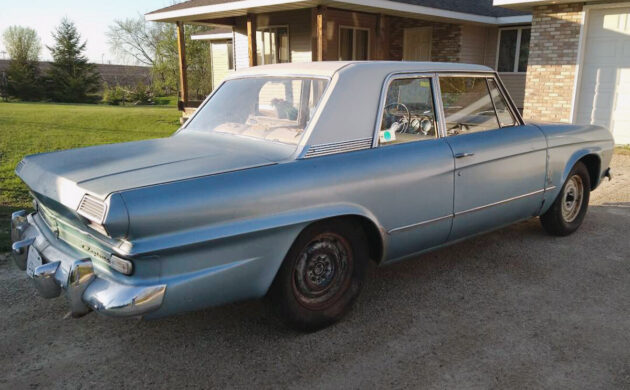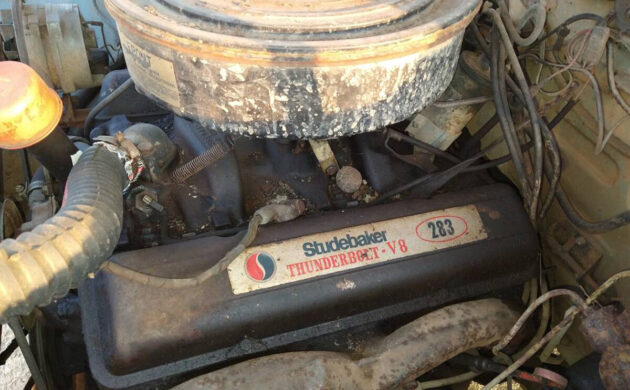The last-year Canadian Daytonas are easy to recognize with the new grille and single headlights. I don’t know about you, but this car is pretty desirable for me being a last-year two-door car with a V8. The seller has this nice project posted here on craigslist near Rochester, Minnesota and they’re asking what seems like a great price: $3,900 or offer. Here’s the original listing, I don’t think this car will be for sale for too long.
The seller tells us that this last-year Studebaker Daytona is all original and all there. I’m a little surprised to see that a nice-looking two-door V8-equipped Daytona is still for sale for less than $4,000. The unique 1966 grille and single headlights would really set this car apart from most others at a Studebaker meet or car show.
Studebaker’s South Bend, Indiana plant closing in late-1963 meant that the following three years of production would take place in their Hamilton, Ontario, Canada facility. There are some reports that give the reason why Canadian production continued after South Bend closed up shop is the threat of dealer lawsuits. It was a sad end for the oldest car maker as the board of directors basically wanted to get out of the car business and car magazines wouldn’t even give these cars the time of day, let alone much press at all.
The interiors were a step above previous Studebakers and this one presents relatively well despite needing some obvious upholstery help, new carpet, and most likely a few other things. The seller says, “Seats are crunchy and foam inside is degrading” so they do need more than just new vinyl. The seller talks about the history of this car: “I believe this car was last driven in the early 1990’s (his grandfather’s car) and sat in a barn from then till 2010.” They go on to say that since 2010, it has sat in their garage so this car hasn’t seen much use over the last few decades.
On top of being a solid-looking two-door, which is always popular, this car has a Chevrolet-sourced 283 cubic-inch V8 which would have had 195 horsepower. The seller says that it doesn’t currently run or stop but the engine isn’t stuck and the car rolls around fine. It’s been sitting for a long time which may have preserved the body but didn’t help the mechanical bits. Hagerty is at $8,700 for a #4 fair condition car and $12,100 for a #3 good condition car so there’s a lot of room to turn this car around if a person does a lot of the work him/herself. Any thoughts on this ’66 Daytona? Good buy or goodbye?







That is a really neat Studebaker Daytona and the only one I have ever seen. That last picture in the listing shows how cool the car could be made to look. The front end reminds me of the 1972 Opel Kadett my best friend in high school owned. The rear of the car has a design as unique as I have ever seen. It seems like a great deal and I hope a BarnFinds enthusiasts ends up with it.
They had a single headlight design back in 64. I owned a 1964 Challenger, yes Studebaker used this name on a base lark. Had the 170 six and three on the tree. My second car wasn’t fast and needed that STP to keep the oil from getting by the rings. I usually got me around.
That rear-end design was a clever solution by Brooks Stevens to update the round-taillight ’62-63 Lark without having to invest in changing the rear fender stampings. By this year, the taillight housings also incorporated air extraction grilles for the new flow-through ventilation system.
I’m glad I’m not the only one who mistakenly thought this was a Opel. Love the Studebaker Daytona coupe. Make mine a 1965 model though with a 4-speed. And if you have the R2 option yes please!
Actually my Canada built 1964 4sp Daytona was sold new in Illinois and was the last year for the R- series motors based on the original 1951 V/8 Studebaker motors. 1965 – since they all were being built in Canada they were able to supply the Chevrolet motor and still be legal. Still would like to own a 65/66 Daytona – this one’s nice for the money.
You are correct and I realized my mistake after I posted the comment.
These are not a coupe. It is a 2 door sedan. There were no R2s after 64.
There is one of these…not sure the year…that runs in vintage races in Europe.Does very well.
I know that the word “sleeper” is overused on BarnFinds, but I would drop in a 400 sbc and leave the original 283 valve covers stickers on it.
400s were not real stable, walls too thin. Stick with a 350, they work well. Of course, just rebuild what is in there, that is original (if you like that sort of thing)
283 valve covers on a 400 would not work very well, there would be no crankcase ventilation. 400 is vented through the valve covers, and the 283 was vented through the oil fill tube in the front of the intake manifold and the vent in the block behind the distributor. small journal 327 would work fine though, and they can make some healthy power too.
Gone.
There’s something of the Mk. 2 Cortina about it, too…
Already sold nice unusual car worth restoring someone got a great deal if it went for advertised price – or less!!
I never understood why, when they started using Chevy engines, they didn’t use GM transmissions as well.
They had used that transmission for many years behind Studebaker engines and the parts existed to mate it to engines utilizing the Chevy bellhousing bolt pattern (Checker was also using the same transmission behind the small block Chevys that it was buying from GM at that time), so Studebaker apparently decided that there was no compelling reason to have to buy both engines and transmissions from GM of Canada.
The transmission that GM would have offered to sell them back then would likely have been the Powerglide anyway — not a “must have” item, even in 1965-66.
In the ’80’s, I had a ’66 Daytona 4dr sedan. Bought it cheap, nice car, bad brakes (disc front).
Apparently the discs were Girling and some items interchanged with Jaguar of the time, while others were unique. A complete pain to find parts for and get working. After two shops gave up, I found an earlier Daytona in a boneyard with drums and swapped the entire front suspension/brakes in an afternoon.
Drove it for about a year until a restorer talked me ought of it. It was a nice car, 283 V8/auto, just the right size for the city.
I still miss the ’51 Land Cruiser I grew up with.
As a Studebaker lover, I am saddened to see this blahhhhh mechanical blob wearing the same name badge as the magnificent Grand Tourismo Hawk. What a pitiful ending if a once great marque.
This ’66 was sized and priced to compete with Chevy II and Valiant 2-door sedans. Personally, I prefer it to either of those. Came standard with full instrumentation, transistorized ignition, and could be had with disc brakes and reclining seats, which neither Chevy II nor Valiant had.
P.S. It’s ‘Gran Turismo’, not ‘Grand Tourismo’.
Following that logic:
The GT is a sorry rework (just to copy the T-bird) of the sleek finned Hawks, which
were already a trendy rework of the original Speedster just to follow the
tack-on-fin school of styling.
Each iteration must be viewed and enjoyed on its own merits; comparing them to
their predecessor or successor is ignoring the vehicle and why it was created.
Studebaker was a great manufacturer, all of their products had merit and value,
but they were predominately steam-rolled by the big three in all areas.
When I got in my ’66 Daytona and compared it to my ’66 Cutlass (in spirit, a close
competitor) or ’64 Starfire there was no comparison (all were similar mileage used
cars then). Fit, finish, construction integrity, construction quality, and material quality
were not in the same class.
I had to be true to my family and purchase what I considered to be the best long-term
value. When I saw 3 year old GT Hawks going down the road with a rust line down the
rear of the front fenders just like the ’53 Speedsters did in 1955, I could not in good
conscience buy one.
I truly wish Studebaker would have been able to be in the same class but their
circumstance did not allow it. I was (am still am) a great fan of their products.
So what Chevy did to their trucks starting in 1973 and ending in 1987 for the pick up’s – the Suburban’s ran a few more years – with that basic square body – was not an overuse ? They still sold a lot of them though they had that nasty gas tank court case.
Amazing that Studebaker survived, after Packard bought them out.
One of the worst examples of one company (Packard) buying the other one out.
Only to have that buyout result in the buyer going under.
Yep, one year after the last product called a Packard was made, Studebaker made its largest profit in the company’s 107-year history. Stude made cars for a decade after Packard dropped out.
Wrong Emel – Stude bought Packard !
Wrong, stllrunners…. Packard bought Studebaker. It’s widely reported in a lot of places. I’m a Studebaker guy, but they had a thoroughly spoiled workforce and spent more on early-postwar product than Packard did, surely. Packard had more cash on hand, but according to an article in Business Week then, Packard was the bigger loser of the two by mid-1956.
Comparing a ’66 Daytona to a ’64 Starfire? Would you compare a ’66 Valiant to a ’66 Pontiac Grand Prix? I had a friend who would compare his ’56 Packard Patrician to my ’63 Lark Daytona Skytop. I said, “That’s comparing a Chevy II to a Coupe deVille”. He didn’t like that.
Exactly….to a Falcon – Chevy II or others there was not a comparison.
I see a 10 yr later pontiac ventura in the grill too.
Sharp lill car, along the lines of an oe souped up falcon or chevy II. Mid or downsized but still a decent SB (4.6L). Just right in my book (for canyon carvin mods)..
I really like the last body stylings of the Lark , they finally got rid of the chunky posts and the wavy body lines that made them look bent in the middle , but really, the platform is just a cutdown version of the same stuff they were bringing out since the 50s, and automotive people knew it. The GT Hawk ? Same platform as the 53 model, and still really looked like it 10 years later. The Lark may have been one of the first successful compacts , but it was still a dated frame on body platform while others were lighter unibodies .Even the Avanti , which looked new and futuristic with its fiberglass body, was still basically a 53 Studebaker underneath. All the innovative firsts they came out with couldn’t save them from poor management and bad decisions
The 1962 Corvette was still a body-on-frame with 1949 Chevy kingpin front suspension, at the time the Avanti was being introduced. Some GM large cars were still using “R” at the bottom of the quadrant in ’63-64. Studebaker offered disc brakes and a three-speed automatic with quadrant PRND21, which weren’t available on any Chevy, even Corvette, in the 1964 model run.
That’s true, but a 66 Chevy Impala does not look like a 53 Chevy with tacked on trim , and they weren’t using a dated 13 year old platform to build their cars on.
Because they could afford to , the Big Three offerings were constantly being updated or changed completely, which is what the buying public wanted. Nobody wanted a new car that looked five or more years old , and Studes sales were affected . As I said , they had new innovations ,and standard features that on other makes were options ,but poor money management doomed them. I’ve always wondered that instead of building lousy selling Packardbakers they just eliminated Packard completely but kept the drive train for their model cars, there would have been enough money to come up with a more up to date full size car when the Lark was introduced .
Why compare a ’66 Daytona to a ’66 Impala? Complete apples-and-oranges. Your opinion is your opinion of course, but there is not a single, solitary piece of trim, sheetmetal, or glass that is interchangeable between a 1953 and 1966 Studebaker. Zero. Methinks you are forgetting what a 1966 Valiant, Rambler, or Chevy II two-door sedan looks like, inside and out. That is where Studebaker was marketing this car, siz-wise and price-wise. I’d choose the Stude over any of those cars.
I’m not comparing an Impala to a Lark , I’m comparing the huge changes GM did with just that model, while Studebaker kept on hashing out the same basic platform from 53 -on. and while the GTs had updated with the Tbird style roof lines, there was no mistaking their mid 50s Hawk lineage , where , cars in that class like the Tbird had massive changes in the same time period . The Lark itself was basically a full size 58 model with a shortened frame and different front and rear clip. The doors and roofline were the same . I know they were struggling at that time and had to make do with what they had, again, its widely known poor management killed the car off. They weren’t bad cars , but bad decisions sealed their fate
Larks were serious rusters compared to the Falcons , Ramblers , Valiants and Chevy IIs and that didnt help their reputation . You obviously are a big Stude fan which is great , but the competition at the time was building better and more popular compacts.
Karl, the reason why the Packard V8 engine bit the dust was because S-P closed down the entire Packard Detroit plant complex, including the foundry, and South Bend didn’t have the resources to continue the larger Packard V8 engines.
And while the Packard V8 was a tight squeeze in the 1956 Hawk, trying to get one into the Lark engine compartment would have taken some major redesigns. The Packard V8 was a true big block, capable of being enlarged to well over 440 cu in.
Without a doubt, the Daytona is the most collectible of the Lark line. I have a 1964 2 Door convertible. While I would prefer a Sport Coupe, unfortunately not many were made or survive and rarely do they come on the market. The problem with this car is the overall condition. If the mechanicals aren’t too bad, the body looks fairly intact and if you do much of the work yourself, you’ll have nice car that should increase in value – but not as much as you think. A full redo in near original condition could hit $20k. There’s a more desirable pillar-less hardtop 64 on e-bay but it’s price point is several times higher so this certainly priced fairly for a restore project.
That’s true, but a 66 Chevy Impala does not look like a 53 Chevy with tacked on trim , and they weren’t using a dated 13 year old platform to build their cars on.
Because they could afford to , the Big Three offerings were constantly being updated or changed completely, which is what the buying public wanted. Nobody wanted a new car that looked five or more years old , and Studes sales were affected . As I said , they had new innovations ,and standard features that on other makes were options ,but poor money management doomed them. I’ve always wondered that instead of building lousy selling Packardbakers they just eliminated Packard completely but kept the drive train for their model cars, there would have been enough money to come up with a more up to date full size car when the Lark was introduced .
I’m not comparing an Impala to a Lark , I’m comparing the huge changes GM did with just that model, while Studebaker kept on hashing out the same basic platform from 53 -on. and while the GTs had updated with the Tbird style roof lines, there was no mistaking their mid 50s Hawk lineage , where , cars in that class like the Tbird had massive changes in the same time period . The Lark itself was basically a full size 58 model with a shortened frame and different front and rear clip. The doors and roofline were the same . I know they were struggling at that time and had to make do with what they had, again, its widely known poor management killed the car off. They weren’t bad cars , but bad decisions sealed their fate
bone, come on, it’s not hard to see why the Chevy II and Falcon were more popular, duh. The public was pretty freshly-reminded of the disappearance of Packard, Edsel, and DeSoto only a handful of years earlier. Closing of South Bend did nothing for public confidence. I can tell you that neither Falcons nor Chevy II’s had front fender liners and as a kid I can remember a ’65 Chevy II that had patches over the headlights that resembled band aids. This would’ve been still in the sixties. Falcons with their drop-in gas tanks, brilliant idea. I have a good friend who worked on all of them back then. He says Larks were definitely more robustly-built than early Falcons or Chevy II’s. I personally don’t care about popularity. If you judge by that, then McDonald’s is the best fast-food available. I grew up in a staunch Chevy family, but I hate ’66 and ’67 Chevy II’s for styling. Dumpy. Droopy rear wheel openings, weird front wheel openings, etc. You are of course entitled to your opinion as I am to mine. No one in my family owned a Studebaker, but I have owned four. I think they did a lot more in their final few years than AMC and probably more than some of the Big Three compacts. But make no mistake, Studes were compacts and as such should be compared, item-for-item, with contemporary competition.
I bought this 1966 Daytona. Had not run in 40 years, had a bad respray sometime in its life, and the interior is all there but pretty much shot.
I’ve now got it running, driving and stopping. Very peppy for a 283 two barrel with 2 speed auto. Came with a pair of NOS front fenders and a parts car. My question is what color is it? Looks like Laguna blue to me, but to my knowledge Studebaker did not offer Laguna in ’66. Color looks to be original. Trunk, Engine bay and door jams all match exterior. Anybody got any advice?
Jon – Congrats on your Daytona acquisition. Glad to hear you have it roadworthy if not show-ready yet. It appears from sales literature that Laguna Blue was in use in 1966 but I can’t tell you with certainty. Also, the Canadian plant did have differing color codes/names from time to time. 1965 and 1965 saw a lot of 1 year only and partial year only colors from Studebaker.
I suggest ordering a build sheet from the Studebaker National Museum for the exact factory color code.
Bob
I have owned two 1966 Studebakers (and own one currently). Laguna Blue was not offered in 1966. I’m looking at Studebaker’s 1966 “Sapphite Lustre Finishes” folder and your car appears almost-certainly to be “Niagara Blue Mist”, a metallic. My first ’66 was that color and to my eyes it actually appeared a very light green instead of blue but that may have been my eyes.